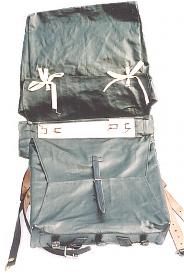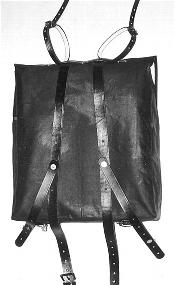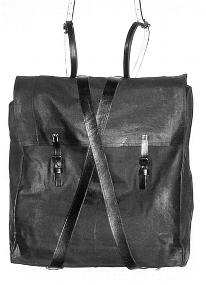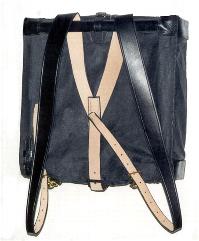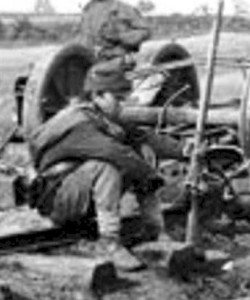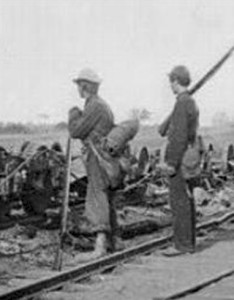Hitting the Dusty Trail
Or
A Primer on Carrying Your Personal Truck
by Bobby Hughes
As infantry, our home should always be considered to be on our backs. Even at “garrison” type events, individuals should keep in mind that life was not always dry tents, chairs, and comforts.
The most common means of carrying your personal effects is of course, the knapsack. Pre-war knapsacks were frequently a hard pack, with a wooden frame covered with painted canvas. These were in particular fashion for the militia units in the north and south. The Federal Government had started issuing soft packs, made of painted cloth since the War of 1812. The most common Federal knapsack is the Model 1853/1855 double bag, which has a “box” bag and envelope bag.
Confederate troops later also made use of captured Federal knapsacks; home produced knapsacks, and imported English pattern knapsacks. Confederate knapsacks include the single bag, Mexican War pattern, and Isaac & Campbell.
Confederate Single Bag
Isaac and Campbell or English Knapsack
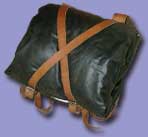
 Mexican War or “Kibbler” pattern Knapsack
Mexican War or “Kibbler” pattern Knapsack
The knapsack was both a discomfort and aid to the soldier on campaign; even when packed light, the straps would often cut into the shoulders. Many soldiers soon abandoned the knapsack in favor of the bed roll. Soldiers did not, as Civil War legend will tell you, throw them away, as they would be charged the loss of their clothing and equipment which would be deducted from their pay. At the start of the Atlanta Campaign in April, 1864, Sgt Lyman Widney of the 34th Illinois Infantry wrote that they were shipping their personal property home, rather than leave it in their knapsacks, which were apparently going into storage. This would indicate a heavy use of bedrolls at least by this unit during the fighting in
Georgia.
Bedrolls came in two styles. The famous horse collar and the short or hobo roll. The horse collar can be seen in numerous images of the war, and was very popular among Confederate troops. The horse collar was fashioned by laying the blanket out its full length and width. It was then folded in half length wise, and ones effects layed out on it. By the later stages of the war, these were often reduced to a change of socks, shirt, and drawers, and a few small items such as a toothbrush. Soldiers had learned what they needed, and what they didn’t, and traveled as light as possible. The whole was then rolled length wise and secured in the middle with a tie or coat-strap. The roll was then given a couple quick twists, and then doubled back on itself and the ends secured together with another tie or coat-strap. It could then be worn over the shoulder. The drawback to this method was that the blanket lay across the chest and could prove very warm in summer months.
The other method, the short roll, took a few more items to make, but proved a bit cooler. To make the short roll, the blanket was first laid out as in making the horse collar. It could then be doubled lengthwise, and again the personal effects laid out in the center. It was then rolled width wise to form the roll. It was then secured with either ties or coat-straps, or a rope could be used to tie the ends, leaving plenty of slack in the middle to slip it over the head and shoulder. Soldiers would sometimes use the rifle sling to sling the short roll.
The Horse Collar method of making a bedroll,
here used with a knapsack
The short or hobo roll
Whatever method you choose to utilize, the one thing that should matter most is personal comfort. Wear it, take it for a walk, and decide what is comfortable. Also think about “what do I really need, and what can be left behind. If its summer, leave the overcoat; you probably wont need it, and if you do get chilly on picket, use your blanket as a shawl. Another thing to think about is weather… your rubber blanket, poncho, or oilcloth should be easily at hand should the weather turn wet. With a knapsack, this can be done by placing it between the bags of a double bag or Kibbler, or under the straps of a single bag, or under the straps of an I & C. With a bedroll it can be trickier. You can carry your poncho or rubber blanket folded over your belt or you can get wet, leaving your bedroll secured inside the waterproofing. You can also fold it, and tie it to the outside, so you can get it quickly. It’s all up to you and what works for you. From personal experience, I have pared my gear down to 39 lbs total weight, including bedroll, haversack, full canteen and rifle-musket. I have no doubt I could pare this down even further.
There is a great propensity to fill every bit of room in a knapsack, resulting in packing a lot of truck you don’t really need and won’t possibly use. Pvt Carlton McCarthy, of the Richmond Howitzers, reduced the Confederate Soldier thus:
“The haversack held it’s own to the last, and was found practical and useful. It very seldom, however, contained rations, but was used to carry all the articles generally carried in the knapsack; of course the stock was small. Somehow or other, many men managed to do without the haversack, and carried absolutely nothing but what they wore and had in their pockets.
The knapsack vanished early in the struggle. It was inconvenient to ‘change’ underwear too often, and the disposition not to change grew, as the knapsack was found to gall the back and shoulders, and weary the man before half the march was accomplished. The better way was to dress out and out, and wear that outfit until the enemy’s knapsacks, or the folks at home, supplied a change. Certainly it did not pay to carry around clean clothes while waiting for the time to use them. Very little washing was done, as a matter of course. Clothes once given up were parted with forever.(1)
Reduced to the minimum, the private soldier consisted of one man, one hat, one jacket, one shirt, one pair of pants, one pair of drawers, one pair of shoes, and one pair of socks. His baggage was one blanket, one rubber blanket, and one haversack. The haversack generally contained smoking tobacco and a pipe, and a small piece of soap, with temporary additions of apples, persimmons, blackberries and such other commodities as he could pick up on the march”
One thing that must be taken into account with McCarthy’s writings is it (like many other memoirs) was post war, and like many of his contemporaries, he sold up the “ragged Rebel” myth. General Robert Rodes said, after the battle of Chancellorsville:
“The enemy abandoned such a large number of knapsacks that when this division began its homeward march in the rain it was thoroughly equipped with oilcloths and shelter tents of the best quality.”
No doubt that along with the shelter tents and oilcloths was a goodly number of knapsacks. The knapsack did not disappear as quickly as McCarthy would have us think. Even in the West Confederate soldiers continued to use knapsacks. The number of extent surviving knapsacks would dictate and continued use throughout the war. During the Gettysburg Campaign, Lt Col Arthur Fremantle, of the Coldstream Guards, a British observer traveling with the Army of Northern Virginia noted about Barksdale Mississippi Brigade:(2)
“All were well shod and efficiently clothed. The knapsacks of the men still bear the names of the Massachusetts, Vermont, New Jersey or other regiments to which they originally belonged.”
The late Brian Pohanka, in the text for Don Troiani’s book of paintings, notes that the knapsacks carried by Barksdale’s Brigade were issued in June of 1863, after the battle of Chancellorsville and Second Manassas.
Now, let us discuss what you really need or will use in field, especially in a campaign environment. Of course you need a blanket and a rubber blanket, poncho, or oilcloth/painted ground cloth. At the minimum this would be all you would need, but you can throw in a shelter half if you wished (especially if we are doing Federal) With a good pard, you can put your ground cloths down, put a one blanket on the ground cloths as insulation, and share the other blanket. In inclement weather, you can pull one of the waterproofs over you both, if you are not using a shelter tent or fly. You will also need a plate or small frying pan or canteen half. You will only need ONE of these; with a plate or a canteen half you can split a stick and use the split end to hold the plate or canteen half for use as a frying pan. You should have a boiler, this can be a tin can “field made” boiler (available form several vendors), a field modified army cup, or a Billie cup. You can also just use your dipper. You will also need something to eat with. Your mess furniture need not be elaborate. It can be as simple as a period correct pocket knife, a spoon, and your fingers. There is no need for fancy matching mess tools; you can also use the handy little folding numbers that will ride nicely in your pocket. In regards to pocket knives, these are almost indispensable in the field, and while not essential, you might want to see if your pard has one or if you borrow one from another pard when you need one. Belt knives were known, but the big D guard Bowie was often dispensed with early in the conflict. A good bet is to have one butcher type knife in your mess, and take turns carrying it and the other mess gear. A change of shirt and socks is almost essential for changing shirts after a hard days marching or fighting will help keep the chill off, as will wearing dry clean socks to sleep. 20 to 50 feet of good string or twine should also be carried, and perhaps a few feet of hemp or manila rope, to assist in rigging up shelter for you and your pard. In regard to shelter, do not be afraid to use existing structures if you have access…. They did! In cooler weather, you may want to add a waistcoat and overcoat, but the overcoat is not necessary as you can also use your blanket. You can carry a few candles, and perhaps a small collapsible candle lantern or you can use the bayonet, and leave the space. Another option is to forgo the candles, and just go to sleep. A small tin container of sweet oil (olive oil) or gun oil, and rags to use a cleaning patches, as well as a gun wiper and musket tool (these can ride in your pocket). A small notebook and pencil, can be carried in the coat pocket, and is useful for jotting down thoughts, emergency fire starter, or emergency “necessary” paper. You may want to carry a small piece of soap, and a small towel (not a terry cloth towel but a “huck” towel often available at Samuel Walton’s Emporium and Dry Goods, or other vendors. You could also carry a small pocket testament. Many of the other falderal that you often see folks laden down with can be left. Ink and pens are not necessary, nor is a razor, cards, and many of the other “haversack stuffers” carried by vendors.(3) If you need prescription meds, these can be carried in a poke sack or a small tin container (if it’s a medication that, for legal reasons, must be in an original container with your name on it, just slip it into a poke sack.)
One thing to keep in mind when thinking about a knapsack; Quality is everything. Knapsacks are available from many vendors but many of them are poorly constructed or made incorrectly. Knapsacks should be purchased from only reputable vendors such as Missouri Boot and Shoe, LD Hanning, Jarnigan, or Trans-Mississippi Depot or any vendor on the Authentic Campaigner Approved Vendor list. A poorly made knapsack will only cause discomfort and pain, and in the end will not be worth the investment, while a quality pack maybe more expensive, in the long run you will be much happier with it, as will your back!
I hope this little primer has helped in improving your impression. I also hope that it has helped in reducing your personal loads, and will make the events were we ‘campaign’ easier and more comfortable. Work with your pards, and find what works for you, and what doesn’t and adjust as necessary, and you find you can sleep comfortably in the worst conditions.
(1) Echoes of Glory
(2) Don Troiani’s Civil War; Text by Brian Pohanka
(3) Knapsack and Haversack 101 by Kevin O’Bierne, Columbia Rifles

